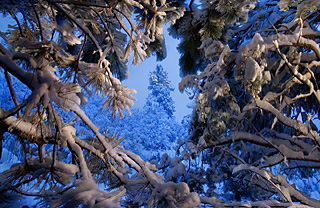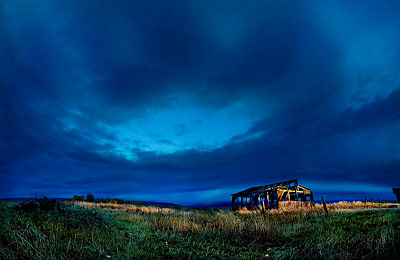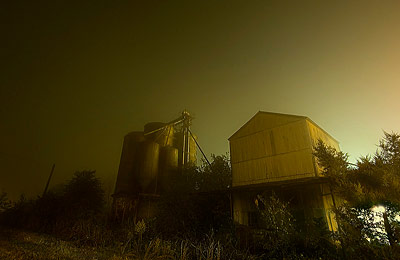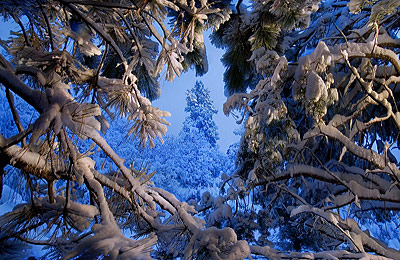 Hi and welcome to this edition of Workshop at the Ranch. Last month I addressed Lightpainting subjects the industry would label as “Table Top” subjects in the studio. This month I thought it would be good to follow up that article by talking about Lightpainting in an outdoor environment. Each of these Lightpaintings feature a strong use of color, environment, weather conditions and of course Lightpainting. Some of the basics of Lightpainting should be kept in mind as you read this article … Tripod, Use the Long Exposure Noise Reduction Mode, Hand Held spot lights …etc, etc. ( NOTE: For those new to Lightpainting you should review past Workshop at the Ranch articles for a basic understanding of Lightpainting in order to fully grasp this months Workshop at the Ranch. ) Now that you have reviewed the previous Lightpainting articles, let’s have a look at the great outdoors as I see it using Lightpainting ……….
Hi and welcome to this edition of Workshop at the Ranch. Last month I addressed Lightpainting subjects the industry would label as “Table Top” subjects in the studio. This month I thought it would be good to follow up that article by talking about Lightpainting in an outdoor environment. Each of these Lightpaintings feature a strong use of color, environment, weather conditions and of course Lightpainting. Some of the basics of Lightpainting should be kept in mind as you read this article … Tripod, Use the Long Exposure Noise Reduction Mode, Hand Held spot lights …etc, etc. ( NOTE: For those new to Lightpainting you should review past Workshop at the Ranch articles for a basic understanding of Lightpainting in order to fully grasp this months Workshop at the Ranch. ) Now that you have reviewed the previous Lightpainting articles, let’s have a look at the great outdoors as I see it using Lightpainting ……….
Hi and welcome to this edition of Workshop at the Ranch. Last month I addressed Lightpainting subjects the industry would label as “Table Top” subjects in the studio. This month I thought it would be good to follow up that article by talking about Lightpainting in an outdoor environment. Each of these Lightpaintings feature a strong use of color, environment, weather conditions and of course Lightpainting. Some of the basics of Lightpainting should be kept in mind as you read this article … Tripod, Use the Long Exposure Noise Reduction Mode, Hand Held spot lights …etc, etc. ( NOTE: For those new to Lightpainting you should review past Workshop at the Ranch articles for a basic understanding of Lightpainting in order to fully grasp this months Workshop at the Ranch. ) Now that you have reviewed the previous Lightpainting articles, let’s have a look at the great outdoors as I see it using Lightpainting ……….
|
 Image #1 Cosmic Aspens … Each fall I look forward to my favorite workshop week of the year, Rich Clarkson’s Photography at the Summit in Jackson Hole, Wyoming. The combination of the Teton Range, fall colors, great workshop faculty, Rich’s stories, cowboy atmosphere, and fly fishing with Ron, make this week very special to me. I usually arrive a few days before the workshop to fly fish with one of my best friends Ron Taniwaki. After a day of fishing on the Snake River it’s dinner time at the Gun Barrel and then off to scout for a Lightpainting location before the sun sets. Ron is a great photographer and very accomplished when it comes to Lightpainting. We found this perfect stand of yellow Aspens surrounded by fire red maple bushes about 6 miles from Wilson, Wyoming outside of Jackson Hole. The clear skies gave us the perfect opportunity to photograph a giant star field and then reveal our subject, the trees, with Lightpainting. We each went our own way regarding composition. Ron shot a vertical image from a location 50 yards to my left while I chose a wide horizontal. Once the sun had set and twilight was finished I set my exposure for the stars in the sky above the trees (take a shot and take a look.) The North Star is centered in the top of the frame. This positioning will help reduce the recorded motion of the stars during the long exposure. My wide angle lens choice, 12mm, will also minimize the stars recorded movement during the long exposure time. Nikon D200, ISO400, 2 Minute Exposure at f4, Nikon 12-24mm Lens, WB 4000K, Nikon MC-20 Electronic Shutter Release with camera set on Bulb, Gitzo Carbon Fiber Tripod, SLIK Super Ball Head, Kirk L Bracket, Two Brinkmann QBeam 2 Million Candle Spot Lights, Lexar 4G Flash Card. The long exposure time of 2 minutes in combination with an ISO of 400, f4 aperture, clear Wyoming sky and our mountain elevation of over 5000 feet revealed over 300 stars in the sky above the trees! My trees were of course in silhouette until I revealed them with Lightpainting. I used a Self Timer Mode of 20 seconds so I could press the shutter and have 20 seconds of time to jog to a position 50 yards to the cameras left and Lightpaint. This is one of my favorite Lightpaintings to date. The brilliant colors of Yellow and Red underneath a massive star filled sky is both beautiful and unique. Ron’s image from another location was equally impressive with a spectacular star field rising above the Lightpainted aspen grove. We both exercised patience by alternating our shots so our individual Lightpainting would not effect each others image. Image #1 Cosmic Aspens … Each fall I look forward to my favorite workshop week of the year, Rich Clarkson’s Photography at the Summit in Jackson Hole, Wyoming. The combination of the Teton Range, fall colors, great workshop faculty, Rich’s stories, cowboy atmosphere, and fly fishing with Ron, make this week very special to me. I usually arrive a few days before the workshop to fly fish with one of my best friends Ron Taniwaki. After a day of fishing on the Snake River it’s dinner time at the Gun Barrel and then off to scout for a Lightpainting location before the sun sets. Ron is a great photographer and very accomplished when it comes to Lightpainting. We found this perfect stand of yellow Aspens surrounded by fire red maple bushes about 6 miles from Wilson, Wyoming outside of Jackson Hole. The clear skies gave us the perfect opportunity to photograph a giant star field and then reveal our subject, the trees, with Lightpainting. We each went our own way regarding composition. Ron shot a vertical image from a location 50 yards to my left while I chose a wide horizontal. Once the sun had set and twilight was finished I set my exposure for the stars in the sky above the trees (take a shot and take a look.) The North Star is centered in the top of the frame. This positioning will help reduce the recorded motion of the stars during the long exposure. My wide angle lens choice, 12mm, will also minimize the stars recorded movement during the long exposure time. Nikon D200, ISO400, 2 Minute Exposure at f4, Nikon 12-24mm Lens, WB 4000K, Nikon MC-20 Electronic Shutter Release with camera set on Bulb, Gitzo Carbon Fiber Tripod, SLIK Super Ball Head, Kirk L Bracket, Two Brinkmann QBeam 2 Million Candle Spot Lights, Lexar 4G Flash Card. The long exposure time of 2 minutes in combination with an ISO of 400, f4 aperture, clear Wyoming sky and our mountain elevation of over 5000 feet revealed over 300 stars in the sky above the trees! My trees were of course in silhouette until I revealed them with Lightpainting. I used a Self Timer Mode of 20 seconds so I could press the shutter and have 20 seconds of time to jog to a position 50 yards to the cameras left and Lightpaint. This is one of my favorite Lightpaintings to date. The brilliant colors of Yellow and Red underneath a massive star filled sky is both beautiful and unique. Ron’s image from another location was equally impressive with a spectacular star field rising above the Lightpainted aspen grove. We both exercised patience by alternating our shots so our individual Lightpainting would not effect each others image.
|
 Image #2 Abandoned Days … Still in Jackson Hole, a few days after our Cosmic Aspen picture, Ron and I headed out at 5:00am to Lightpaint before dawn. While Ron chose to Lightpaint some Cotton Wood trees near a stream I chose this small abandoned farm across the road. The majority of this image is the predawn ambient light conditions where I set my exposure to underexpose the sky by a stop and then reveal my subject, the run down barn, with a shaft of Lightpainting across its side wall and the adjacent tall grass. Without the Lightpainting the barn would be in silhouette but the addition of Lightpainting brings the image alive as though a sliver of sunlight had cut across the land. Nikon D200, ISO100, 15 Seconds at f22, Nikon 10.5mm Fisheye Lens ( fisheye corrected in Nikon Capture NX ), WB 3600K, Gitzo Carbon Fiber Tripod, SLIK Super Ball Head, Kirk L Bracket, Two Brinkmann QBeam 2 Million Candle Spot Lights, Self Timer 20 Seconds to position myself far to the right of the camera, Lexar 4G Flash Card. I chose the Nikon 10.5mm Fisheye Lens to compliment the swirling cloud formation above my subject. The cool blue WB of 3600K gave great drama to the scene while the warm shaft of Lightpainting brought attention to my subject. The use of underexposed ambient light and Lightpainting is a wonderful combination. Image #2 Abandoned Days … Still in Jackson Hole, a few days after our Cosmic Aspen picture, Ron and I headed out at 5:00am to Lightpaint before dawn. While Ron chose to Lightpaint some Cotton Wood trees near a stream I chose this small abandoned farm across the road. The majority of this image is the predawn ambient light conditions where I set my exposure to underexpose the sky by a stop and then reveal my subject, the run down barn, with a shaft of Lightpainting across its side wall and the adjacent tall grass. Without the Lightpainting the barn would be in silhouette but the addition of Lightpainting brings the image alive as though a sliver of sunlight had cut across the land. Nikon D200, ISO100, 15 Seconds at f22, Nikon 10.5mm Fisheye Lens ( fisheye corrected in Nikon Capture NX ), WB 3600K, Gitzo Carbon Fiber Tripod, SLIK Super Ball Head, Kirk L Bracket, Two Brinkmann QBeam 2 Million Candle Spot Lights, Self Timer 20 Seconds to position myself far to the right of the camera, Lexar 4G Flash Card. I chose the Nikon 10.5mm Fisheye Lens to compliment the swirling cloud formation above my subject. The cool blue WB of 3600K gave great drama to the scene while the warm shaft of Lightpainting brought attention to my subject. The use of underexposed ambient light and Lightpainting is a wonderful combination. |
 Image #3 Martin Mill … Image #3 Martin Mill … This day began different than most ………. First, I was in North Carolina … Second, I had my first taste of Liver Mush at Ken and Mary’s Diner. This Lightpainting was shot as part of 3 days of teaching at Gardner-Webb University in Boiling Springs, North Carolina which happens to be the school that my daughter, Haley, attends as a Photography major. Gardner-Webb University has an outstanding photography program that is headed up by Dr. Bob Carey. This was the perfect opportunity to visit my daughter at school and have some fun teaching her and her fellow college students. Once the subject of Lightpainting came up in class Bob suggested that we find someplace that would serve as a good subject for a Lightpainting. We found the old Martin Mill in the town of Ladimore about 15 miles from campus. With 10 students in tow ( including my daughter ) we set out for the mill just before sunset … had a little dinner at the towns restaurant … and then had a course in Lightpainting that included each student making their own Lightpainting of the old Martin Mill. A fog settled in around us during the evening and by the time it was my turn to make the final picture of the night the mill was engulfed in a soup like fog. I Lightpainted the towers from behind the main building then walked around to the side and Lightpainted the building itself. The spot lights illuminated the fog with an ire glow. I used a combination of a cool blue camera WB of 2500K and then placed Yellow Gels over the front of my Brinkmann QBeam spot lights to add a gray/green color cast to the fog and structures. I like this image a lot. Nikon D2Xs, ISO100, 2 minutes 30 seconds at f5.6, Bulb setting with Nikon MC-20 Electronic Shutter Release, Nikon 12-24mm Lens, WB 2500K, Gitzo Carbon Fiber Tripod, SLIK Super Ball Head, Kirk L Bracket, Two Brinkmann 2 Million Candle Spot Lights with Yellow Gels, Lexar 4G Flash Card. No self timer needed as students tripped the shutter for one another once they were in position to Lightpaint. This image demonstrates that often times adverse weather can add great feeling and drama to a picture …. as one student said, “looks like a hurricane is about to hit.”. |
 Image #4 Wonderland … I finally arrived home after three weeks of work on the road and woke up the next morning with 2 feet of snow blanketing Colorado. This was something I had been hoping for, Lightpainting a snow scene. I quickly got out of bed, jumped into some warm clothes, grabbed my D2Xs, Tripod and Brinkmann QBeams and stepped outdoors only 5 feet from my front door. The sky was growing lighter with each passing second so I worked fast and made a test shot ……….WOW,… ISO100, 7 seconds at f22 ….. I had only enough time to make about 5 images before the sky would gain too much ambient light. I aimed my spot lights at the top of the big pine tree for about 4 seconds and then illuminated the pine branches in the foreground for the remaining 3 seconds. This is difficult to make work because there is so little time to Lightpaint but I felt successful and encouraged by the results. Nikon D2Xs, ISO100, 7 seconds at f22, Nikon 12-24mm Lens, WB 3600K, Gitzo Carbon Fiber Tripod, SLIK Super Ball Head, Kirk L Bracket, Two Brinkmann QBeam 2 Million Spot Lights, Self Timer 10 seconds to position myself off to the right of the camera, Lexar 4G Flash Card. I love this picture. It reminds me of a storybook entrance to an enchanted wonderland. Sometimes all it takes is a little “dash” of Lightpainting in combination with the ambient light to set the mood. Image #4 Wonderland … I finally arrived home after three weeks of work on the road and woke up the next morning with 2 feet of snow blanketing Colorado. This was something I had been hoping for, Lightpainting a snow scene. I quickly got out of bed, jumped into some warm clothes, grabbed my D2Xs, Tripod and Brinkmann QBeams and stepped outdoors only 5 feet from my front door. The sky was growing lighter with each passing second so I worked fast and made a test shot ……….WOW,… ISO100, 7 seconds at f22 ….. I had only enough time to make about 5 images before the sky would gain too much ambient light. I aimed my spot lights at the top of the big pine tree for about 4 seconds and then illuminated the pine branches in the foreground for the remaining 3 seconds. This is difficult to make work because there is so little time to Lightpaint but I felt successful and encouraged by the results. Nikon D2Xs, ISO100, 7 seconds at f22, Nikon 12-24mm Lens, WB 3600K, Gitzo Carbon Fiber Tripod, SLIK Super Ball Head, Kirk L Bracket, Two Brinkmann QBeam 2 Million Spot Lights, Self Timer 10 seconds to position myself off to the right of the camera, Lexar 4G Flash Card. I love this picture. It reminds me of a storybook entrance to an enchanted wonderland. Sometimes all it takes is a little “dash” of Lightpainting in combination with the ambient light to set the mood. |
Well, I hope you all have enjoyed this continuation of Lightpainting from last months Workshop at the Ranch article. Four very different images each with there own stylized look accomplished with Lightpainting.
See you next time at Workshop at the Ranch ………………. Adios, Dave
![]() Hi and welcome to this edition of Workshop at the Ranch. Last month I addressed Lightpainting subjects the industry would label as “Table Top” subjects in the studio. This month I thought it would be good to follow up that article by talking about Lightpainting in an outdoor environment. Each of these Lightpaintings feature a strong use of color, environment, weather conditions and of course Lightpainting. Some of the basics of Lightpainting should be kept in mind as you read this article … Tripod, Use the Long Exposure Noise Reduction Mode, Hand Held spot lights …etc, etc. ( NOTE: For those new to Lightpainting you should review past Workshop at the Ranch articles for a basic understanding of Lightpainting in order to fully grasp this months Workshop at the Ranch. ) Now that you have reviewed the previous Lightpainting articles, let’s have a look at the great outdoors as I see it using Lightpainting ……….
Hi and welcome to this edition of Workshop at the Ranch. Last month I addressed Lightpainting subjects the industry would label as “Table Top” subjects in the studio. This month I thought it would be good to follow up that article by talking about Lightpainting in an outdoor environment. Each of these Lightpaintings feature a strong use of color, environment, weather conditions and of course Lightpainting. Some of the basics of Lightpainting should be kept in mind as you read this article … Tripod, Use the Long Exposure Noise Reduction Mode, Hand Held spot lights …etc, etc. ( NOTE: For those new to Lightpainting you should review past Workshop at the Ranch articles for a basic understanding of Lightpainting in order to fully grasp this months Workshop at the Ranch. ) Now that you have reviewed the previous Lightpainting articles, let’s have a look at the great outdoors as I see it using Lightpainting ………. 





